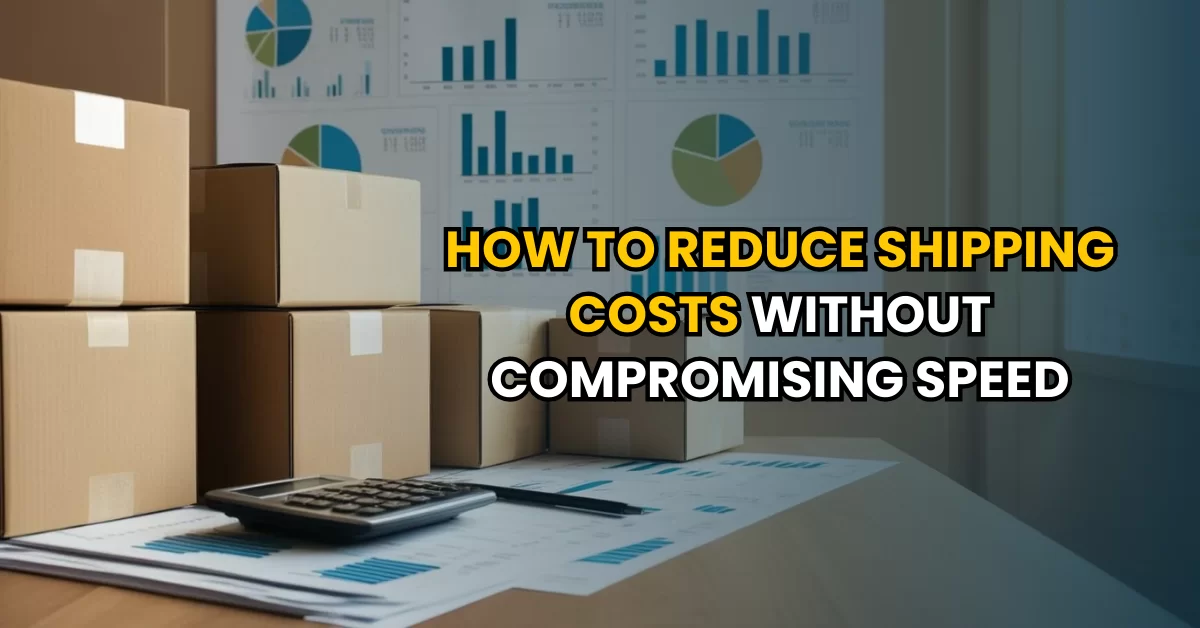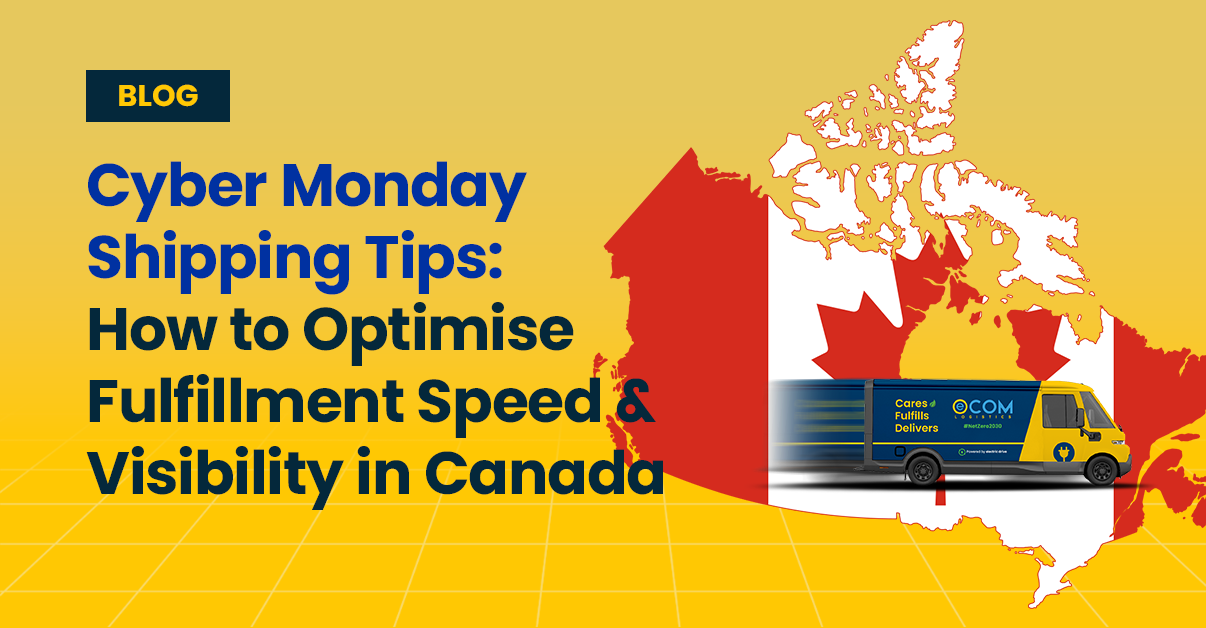Every e-commerce business wants to keep customers happy, and fast, affordable shipping plays a huge role in that. But as shipping rates climb and operational costs add up, finding the right balance between speed and savings can feel like a puzzle.
The reality is, customers expect both—according to one survey, 78% of Canadian customers consider free shipping as one of the top factors influencing their online purchases, and while another survey revealed the same number, i.e., 78% of customers are more likely to buy again from a business that offers same-day delivery. With Canada’s e-commerce market projected to hit over $74 billion CAD in 2025, businesses are looking for smarter ways to optimize logistics without sacrificing efficiency.
The good news? Cutting costs doesn’t have to mean slowing things down. With the right strategies—like optimizing carrier selection, leveraging data-driven logistics, and streamlining fulfillment—you can reduce expenses while keeping deliveries fast and reliable.
Let’s explore the practical and proven ways to lower shipping costs without compromising speed, so you can stay competitive while delivering great customer experiences.
Factors that drive up shipping costs
Keeping shipping costs under control starts with understanding what makes them rise in the first place. Several key factors impact pricing, from fluctuating carrier rates to the logistics of last-mile delivery. Here’s a closer look at what drives up shipping expenses—and how businesses can navigate these challenges.
1. Carrier rates & fuel surcharges:
Ever feel like shipping rates go up every year? That’s because they do. Major national carriers like Canada Post, Purolator, and FedEx adjust their rates in a few years, if not annually. For instance, Canada post is set to increase its rates by 25% in 2025 which is said to be the biggest increase in 10 years. The biggest reasons are inflation, rising fuel prices, and operational costs.
And speaking of fuel—surcharges alone made up a major portion of total shipping costs in Canada. Since fuel prices fluctuate constantly, these fees can change weekly, making it tough to predict costs.
For example –
Let’s say you ship 1,000 orders a month, and your average shipping cost is $10 per order. If carriers raise their rates by 5%, that’s an extra $6,000 per year—without shipping a single extra package. And if fuel prices spike? Expect even higher costs.
2. Last-mile challenges:
Last-mile delivery is the final leg of the journey—getting that package from your warehouse to your customer’s doorstep can sound simple, but it’s actually the most expensive part of the entire shipping process.
The major issues –
- Urban traffic congestion: In cities like Toronto and Vancouver, heavy traffic can cause delays, increase fuel consumption, and extend driver hours. These inefficiencies quickly pile up, especially during peak shopping seasons or bad weather.
- Rural delivery challenges: Serving remote areas isn’t just slower—it’s also costlier. With fewer deliveries per route, your cost-per-package skyrockets, making rural shipments significantly more expensive to fulfill.
- Failed delivery attempts: Missed drop-offs due to incorrect addresses or absent recipients result in additional costs for redelivery, not to mention a hit to customer satisfaction and operational efficiency.
For example –
So, If you ship 100 orders per day, your last-mile costs could vary dramatically—$5 per package in urban areas but $12 or more for rural deliveries. Those extra dollars add up fast!
3. Dimensional weight (DIM) pricing:
Think your shipping costs are based on weight alone? Not quite. Most carriers now use something called dimensional weight (or DIM pricing)—and it can have a big impact on what you pay.
So, what is DIM pricing exactly?
Dimensional weight is a pricing technique that factors in the size of your package, not just its weight. If your item is large but lightweight—like a box of pillows or a bulky toy—it still takes up a lot of space in a delivery truck or plane. Carriers charge based on the space your package occupies, even if it doesn’t weigh much.
How DIM pricing works:
There’s a simple formula most carriers follow to calculate dimensional weight:
DIM weight = (Length × Width × Height) / DIM Factor
- The dimensions are measured in inches, and the DIM factor—which helps convert volume into weight—is typically 5,000 or 7,000, depending on the carrier and shipping method.
- Once calculated, the carrier compares the actual weight of the package to the DIM weight—and you’re billed based on whichever is higher.
Let’s break it down:
Say you’re shipping a box that measures 20″ x 15″ x 10″ and weighs only 4 pounds.
Using a DIM factor of 139 (common in the U.S. for inches), your DIM weight would be:
(20 × 15 × 10) ÷ 139 = 21.58 lbs
Even though the actual weight is only 4 lbs, you’d be charged as if it were over 21 lbs.
Real-world example –
|
Canada Post:
Regular Parcel™ service:
|
Although Ecom Express offers flat pricing to keep your shipping costs predictable, the majority of other carriers still rely on DIM pricing, which means inefficient packaging could be costing you more than you realize.
That’s why optimizing packaging and reducing excess space is key—especially if you’re shipping a high volume of lightweight but bulky items.
4. Fulfillment location & shipping zones:
Where your package starts its journey plays a huge role in determining how much it costs to deliver. Carriers use shipping zones to calculate pricing—the farther your package has to travel, the higher the cost.
Here’s how it works:
Canada is divided into shipping zones. If you’re shipping locally, you’ll fall into a lower zone (like Zone 1 or 2). But send that same package across the country—from Vancouver to Halifax, for example—and you’re now in Zone 8, which can cost more.
If you’re operating from just one warehouse, but your customers are spread across the country, those costs can add up fast. Why?
- Longer transit distances mean higher carrier fees. The farther a package travels, the more fuel, handling, and logistical coordination it requires—especially across provinces.
- More time in transit leads to slower delivery times. That can impact customer satisfaction, especially if your competitors are delivering faster from locations closer to their customers.
And it’s not just about distance. Shipping costs are influenced by a mix of factors—including carrier rates, last-mile logistics, package dimensions, and how your fulfillment process is set up.
The good news? You don’t have to overhaul everything to save. By making small but strategic changes—like using right-sized packaging, comparing carrier options, and placing inventory in multiple fulfillment locations—you can cut costs and maintain speedy deliveries.
Proven strategies to lower shipping costs while maintaining speed
Let’s face it—shipping costs can add up quickly. They chip away at your margins and make it harder to offer competitive pricing. But here’s the thing: cutting costs doesn’t have to come at the expense of speed.
The key lies in shipping smarter—by optimizing every part of the process, from choosing the right carriers to how you package and fulfill your orders. Let’s see what we can do to make that happen –
1. Choose the right carrier & service level
Not all carriers charge the same, and sticking to just one can mean overpaying when there are better options out there. The right carrier mix can help you save money and improve delivery times—without cutting corners on service. A little strategy goes a long way in keeping costs down and customers happy.
- Compare Regional vs. National Carriers – National carriers like Canada Post, FedEx, and UPS are great for cross-country shipping, but regional carriers like Ecom Express can be much cheaper for local deliveries. Regional carriers often provide faster transit times within specific zones, reducing shipping costs while maintaining speed. Evaluating coverage areas and service guarantees can help determine the best fit for your shipping needs.
- Use a Hybrid Shipping Model – Instead of shipping every package via express services, businesses can combine cost-efficient long-haul freight (rail or truck) with local last-mile couriers for the final delivery. This approach helps lower costs without compromising speed, making it ideal for e-commerce businesses handling high volumes. Many retailers use this model to optimize supply chain efficiency while meeting customer expectations.
- Diversify Your Carrier Network – Partnering with 2-3 different carriers ensures you always get competitive rates. By using multiple carriers, you can reduce reliance on a single provider, avoid peak-season surcharges, and ensure consistent service levels even during disruptions.
Pro Tip: Many carriers offer volume discounts—if you’re shipping regularly, negotiate your rates! A strong shipping history and steady volume can give you leverage to secure lower per-shipment costs, helping you save significantly in the long run.
2. Use zone skipping & distributed fulfillment
The further a package travels, the higher the shipping cost—it’s that simple. Carriers use zones to calculate pricing, so if you’re constantly shipping across multiple zones, you’re likely overpaying. The best way to cut those costs? Get your inventory closer to your customers.
- Leverage Zone Skipping – Instead of shipping every package individually across multiple zones, zone skipping lets you group orders headed to the same region and send them together in one bulk shipment. That shipment goes straight to a hub near the final destination — skipping over the zones in between. Once it gets there, a local carrier takes care of the last-mile delivery. This not only helps you save on long-distance shipping fees, but also gets packages delivered faster since they avoid unnecessary stops along the way. Fewer touchpoints, lower costs, and happier customers.
- Use Distributed Fulfillment – Storing inventory in multiple fulfillment centers means orders can ship from the closest location, reducing both transit time and costs. This is especially useful for e-commerce businesses dealing with high order volumes. Instead of sending every order from a single warehouse, spreading inventory across regions helps avoid unnecessary shipping fees.
Pro Tip: Managing multiple warehouses might seem overwhelming, but partnering with a third-party logistics (3PL) provider can make it simple and efficient. Providers like Ecom Logistics operate warehouses in key locations across Canada, helping you stay closer to your customers and speed up delivery times. Plus, with strong partnerships with major carriers, they can secure competitive rates and ensure reliable shipping—so you get better coverage, lower costs, and happier customers.
3. Optimize packaging to reduce DIM weight charges
Carriers don’t just charge by weight—they charge by size too. Dimensional weight (DIM) pricing means that if your package is larger than necessary, you could be paying way more than you need to. The key is to minimize wasted space while still keeping products safe.
- Use Right-Sized Boxes – Oversized packaging doesn’t just waste space—it adds unnecessary shipping costs. If your boxes are bigger than they need to be, you’re likely being charged for the extra volume. Switching to better-fitting packaging helps you avoid those added costs, keeps your items more secure during transit, and reduces the need for excess filler materials. It’s a simple change that can make a big impact across your shipping operations.
- Switch to Lightweight Materials – Packaging doesn’t have to be bulky to be protective. Switching to air-filled pillows, poly mailers, or even compostable packaging can significantly lower the weight of your shipments while keeping products secure. For soft goods or non-fragile items, poly mailers can be a game-changer, cutting costs without sacrificing durability.
- Buy Packaging in Bulk – Just like shipping, packaging costs add up fast. Ordering in bulk from suppliers can lead to big discounts, and many vendors offer tiered pricing for higher quantities. If you have consistent shipping needs, negotiating bulk deals can keep costs down in the long run.
Pro Tip: Carriers charge for whichever is greater—actual weight or DIM weight. If your package’s DIM weight is higher than its actual weight, you’re overpaying! Always check your carrier’s DIM factor and adjust packaging sizes accordingly to avoid unnecessary fees.
4. Leverage technology for smarter shipping
Shipping technology isn’t just for big retailers—it’s a game-changer for businesses of all sizes. With AI-driven tools, businesses can automate key shipping tasks like carrier selection, rate comparison, and tracking. This means lower costs, faster deliveries, and less time spent managing logistics manually.
- Smart Carrier & Rate Selection – Manually comparing shipping rates or picking a carrier for every order takes time and leaves room for error. With smart shipping rules based on destination, weight, or delivery speed, you can automatically choose the most cost-effective and reliable carrier every time.
- Real-Time Tracking – Delays happen, but keeping customers informed makes all the difference. Real-time tracking tools help you stay on top of delivery statuses and proactively address issues, leading to fewer support inquiries and happier customers.
Pro Tip: Many shipping platforms integrate directly with your e-commerce store, letting you automate everything from checkout to delivery. By setting up shipping rules and alerts, you can run a more efficient operation and focus on growing your business.
5. Offer incentives for cost-efficient shipping choices
Not every order needs to arrive overnight, and many customers are willing to wait a bit longer if it means saving money. By guiding shoppers toward more cost-effective shipping options, businesses can reduce expenses while still delivering a great experience. The key is to make slower shipping feel like a perk rather than a trade-off.
- Promote Economy Shipping – Most customers don’t need their order the next day, but they might still select express shipping by default. Offering incentives—like discounts, cashback, or loyalty points—for choosing standard shipping makes it an attractive choice. This can significantly reduce reliance on expensive expedited options while keeping customers happy.
- Set Free Shipping Thresholds – Free shipping is a powerful motivator. By offering it on orders over a certain amount (e.g., $75), businesses encourage customers to add more items to their cart. This strategy not only offsets shipping costs but also boosts revenue—companies using this approach see significant hikes in average order values. It’s a simple way to make shipping more cost-effective and increase sales.
- Create Membership Programs – Amazon Prime has set the standard, but even smaller brands can benefit from a subscription-based shipping model. Offering an annual membership for perks like unlimited free shipping or exclusive discounts can help cover logistics costs while increasing customer loyalty. Once customers commit to a membership, they’re also more likely to shop with you regularly.
Pro Tip: Customers are willing to wait a little longer for free shipping, especially if they know upfront when to expect their order. Use this to your advantage by optimizing fulfillment and choosing cost-effective carriers without compromising delivery expectations!
How Ecom Express helps e-commerce brands reduce costs
Let’s face it—shipping isn’t cheap. And if you’re running an e-commerce business in Canada, you’ve probably felt the pressure of balancing fast delivery with rising logistics costs. That’s where Ecom Express comes in.
We’re all about making last-mile delivery smarter, not more expensive. Here’s how we help brands like yours save money while keeping customers happy:
- Fast, flexible delivery options – Need it there today or tomorrow? No problem. We offer same-day and next-day delivery across major cities in Canada, so your customers get their orders quickly—without you paying premium rates every time. Our delivery speeds are backed by real-time tracking and proof of delivery for full visibility.
- Flat pricing, No surprises – Unexpected fees can ruin your margins. That’s why we keep our pricing model simple and predictable—with flat rates and no hidden costs. You’ll always know what you’re paying for upfront, making it easier to forecast and scale your logistics strategy.
- Sustainable delivery with EVs – We’re driving toward a greener future with an expanding fleet of electric vehicles (EVs). By reducing emissions and fuel costs, we help your brand stay environmentally conscious while also delivering efficiently in busy urban areas.
At the end of the day, reducing costs doesn’t mean cutting corners. With Ecom Express, it means making smarter choices at every step of the delivery journey.
Final thoughts
Shipping smarter doesn’t have to mean slowing things down. It’s all about striking the right balance—keeping costs under control while still delivering the speed and service your customers expect.
Sure, balancing fast delivery with budget-friendly logistics isn’t easy—but it’s absolutely doable. With the right fulfillment strategies, thoughtful carrier choices, and a bit of tech on your side, Canadian e-commerce businesses can ship efficiently without overspending.
That’s where Ecom Express comes in. From optimizing delivery zones to providing flexible shipping options and real-time tracking, we’re here to help you simplify your shipping and elevate the customer experience.
Want to reduce costs without cutting corners? Let’s build a smarter last-mile strategy—together. Contact us today.
Frequently asked questions
1. What’s the cheapest way to offer fast shipping in Canada?
Using a combination of regional carriers and strategically located fulfillment centers is often the most cost-effective way. Services like Ecom Express offer same-day and next-day delivery within major Canadian cities, which can reduce both costs and transit times—especially if your inventory is placed closer to your customer base.
2. How can I reduce DIM weight charges on my shipments?
To lower DIM (dimensional weight) costs, use right-sized boxes and lightweight packing materials. Avoid oversized packaging—carriers charge based on space, not just weight. Tools that help create custom-fit boxes or automated packaging systems can save you a lot over time, especially if you’re shipping high volumes.
3. Is it better to work with one carrier or multiple?
Relying on a single carrier can limit flexibility and cost savings. Partnering with multiple carriers allows you to compare rates, avoid peak season surcharges, and choose the best option based on destination or service speed. Platforms like ShipStation or a 3PL partner can automate this for you.
4. How does fulfillment location affect shipping costs in Canada?
The farther a package travels, the more you’ll pay. If you’re shipping from one central location to customers nationwide, you’re likely paying extra. Using distributed fulfillment—placing inventory in multiple warehouses across the country—can help you reduce both shipping zones and delivery times.
5. Can small e-commerce businesses access bulk shipping discounts?
Yes! Many 3PLs, including Ecom Express, negotiate volume-based rates with carriers and extend those discounts to clients. Even if your order volume isn’t huge, partnering with a logistics provider can give you access to enterprise-level pricing without needing to hit high minimums yourself.
6. What’s the best way to keep shipping affordable during peak season?
Start planning early and diversify your carrier network to avoid inflated rates. Use a hybrid model—bulk ship to regional hubs, then rely on local carriers for last-mile delivery. Tools that track carrier performance and compare rates in real time can also help you avoid last-minute surprises.




